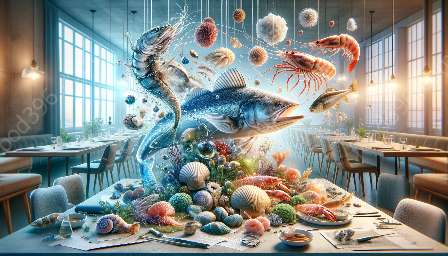Seafood spoilage and shelf-life determination are vital aspects of understanding the biology and physiology of seafood. In this topic cluster, we'll delve into the science behind seafood to explore its freshness, spoilage mechanisms, and techniques for determining shelf life. Let's dive into the fascinating world of seafood and uncover the secrets of its preservation.
Understanding Seafood Spoilage
Seafood, being a highly perishable food commodity, is prone to spoilage if not handled and stored correctly. The spoilage of seafood is mainly attributed to the growth of microorganisms, enzymatic reactions, and chemical changes within the tissue. Understanding the spoilage mechanisms is essential in preserving the quality and safety of seafood products.
Microbial Spoilage
Microorganisms such as bacteria, yeast, and molds are the primary agents responsible for seafood spoilage. These microorganisms thrive in seafood due to its high moisture content, neutral pH, and rich nutrient composition. As they multiply, they produce enzymes and metabolic by-products that deteriorate the sensory attributes of seafood, leading to off-odors, off-flavors, and texture changes.
Enzymatic and Chemical Spoilage
Enzymatic reactions and chemical changes in seafood tissues also contribute to spoilage. Enzymes naturally present in seafood tissue, particularly proteases and lipases, become active post-harvest, leading to the degradation of proteins and lipids. Additionally, chemical reactions such as lipid oxidation and hydrolysis can result in rancidity and off-flavors in seafood products.
Determining Shelf-Life of Seafood
Assessing the shelf-life of seafood is crucial for maintaining its quality and safety throughout the supply chain. The shelf-life of seafood refers to the duration during which the product remains acceptable for consumption under specific storage and handling conditions. Several factors influence the shelf-life of seafood, including its initial quality, processing methods, storage temperature, and packaging.
Predictive Models and Quality Indicators
Various predictive models and quality indicators are used to determine the shelf-life of seafood. These include microbial growth models, sensory evaluation, chemical and physical analyses, and molecular techniques. By monitoring changes in microbiological, sensory, and chemical attributes, the remaining shelf-life of seafood can be accurately estimated, aiding in decision-making for inventory management and distribution.
Biology and Physiology of Seafood
The understanding of seafood spoilage and shelf-life determination is deeply rooted in the biology and physiology of seafood. The biological and physiological characteristics of different seafood species significantly influence their perishability and storage requirements. Let's explore some key aspects of the biology and physiology of seafood that impact its shelf-life and safety.
Respiration and Metabolism
Seafood, as living organisms, continue to respire and metabolize post-harvest, consuming oxygen and releasing carbon dioxide. The rate of respiration and metabolic activity varies among different seafood species and is influenced by factors such as temperature, handling, and storage conditions. Understanding these biological processes is essential for managing the post-harvest shelf-life of seafood products.
Water Composition and Texture
The water composition and texture of seafood play a pivotal role in determining its quality and shelf-life. The water-holding capacity, muscle structure, and connective tissues affect the texture and firmness of seafood. Changes in these attributes due to enzymatic and microbial activities can lead to texture deterioration, making it crucial to understand the biology of seafood to preserve its desirable texture.
Biochemical Composition and Antioxidant Systems
The biochemical composition of seafood, including proteins, lipids, and antioxidants, influence its susceptibility to spoilage. Certain antioxidant systems present in seafood tissues act as natural defense mechanisms against oxidative reactions and lipid oxidation. Knowledge of these biochemical components and antioxidant systems aids in implementing effective preservation methods to extend the shelf-life of seafood products.
Conclusion
Seafood spoilage and shelf-life determination are complex subjects that intertwine the fields of biology, physiology, and seafood science. By gaining insights into the spoilage mechanisms, shelf-life assessment techniques, and the biological characteristics of seafood, we equip ourselves with the knowledge to preserve the freshness and quality of seafood products. This deeper understanding contributes to sustainable seafood management and ensures the availability of safe and nutritious seafood for consumers worldwide.

